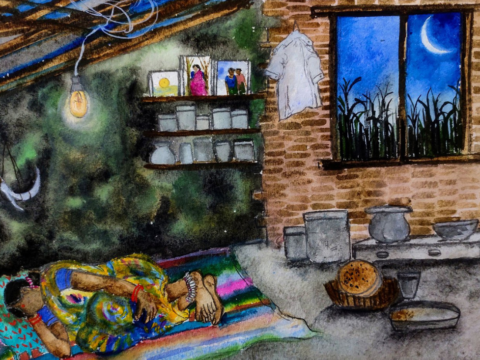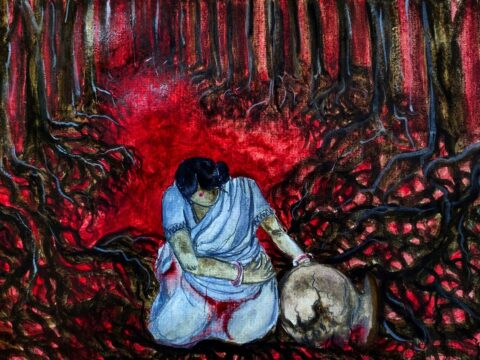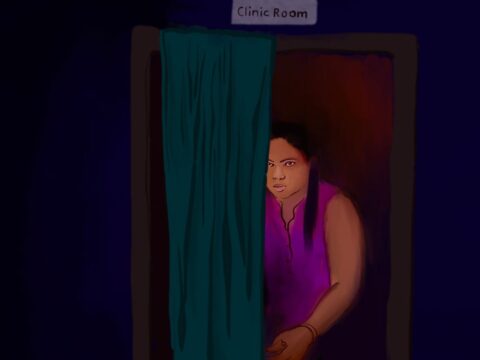
For women of the Bharard pastoralist community in Dholka taluka of Gujarat, the pressure to have sons and few family planning options mean contraception choices and reproductive rights are mere words
“It’s a girl,” said the doctor.
This would be Asha’s fourth child – but surely not her last. She could hear the gynaecologist consoling her mother Kantaben: “Ma, you don’t cry. I will do eight more caesareans if needed. But I am here till she delivers a boy. She is my responsibility.”
Before this, Asha’s three children were all girls, all of them delivered through caesarean surgery. And now she was listening to the doctor pronounce the verdict of the foetus sex detection test at a private clinic in the Maninagar locality of Ahmedabad city. (Such tests are illegal, but remain widely available.) This was her fourth pregnancy in as many years. She had come here from Khanpar village, 40 kilometres away, with Kantaben. Both mother and daughter were inconsolable. They knew Asha’s father-in-law would not allow her to have an abortion. “It is against our faith,” said Kantaben.
In other words: this would not be Asha’s last pregnancy.
Asha and Kantaben are from the Bharwad community of pastoralists, who generally herd sheep and goats. However, most of them in Dholka taluka of Ahmedabad district – where Khanpar is located, their village with just 271 households and less than 1,500 people (Census 2011) – rear cows and buffaloes in small numbers. In traditional social hierarchies, the community is seen as the lowest among pastoral castes and is listed as a Scheduled Tribe in Gujarat.
*****
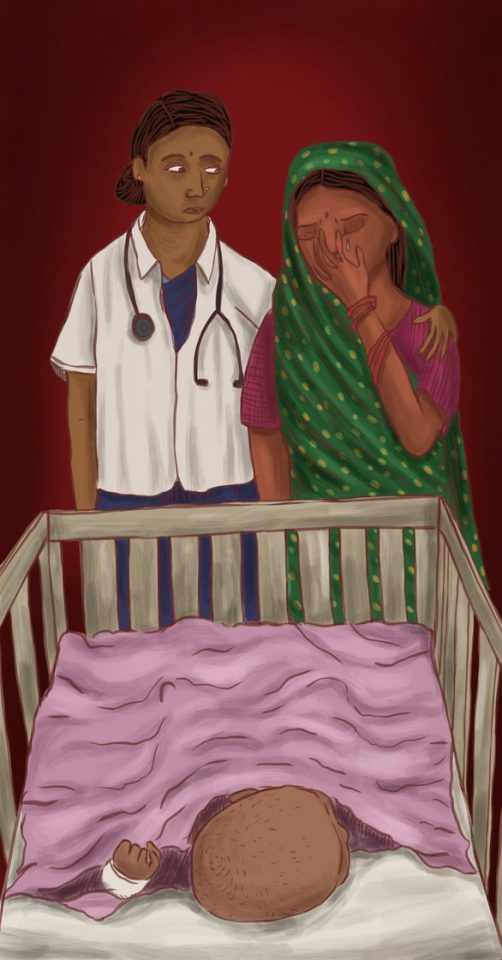
‘You don’t cry. I will do eight more caesareans if needed. But I am here till she delivers a boy’
Kantaben takes off the saree pallu covering her head as she enters the small room in Khanpar where we are waiting for her. A few other women from this and nearby villages have joined us here, to talk about their reproductive health issues – never an easy subject for conversation.
“There are 80 to 90 Bharwad families, small and big, in this village,” says Kantaben. “There are Harijans [Dalits], Vagris, even Thakors, and a few households of Kumbhars [potters]. But the majority of families here are Bharwad.” Koli Thakors are a large caste group in Gujarat – not to be confused with Thakurs in other states.
“Our girls get married early but stay in their father’s house till they are 16 or 18 and are ready to go to their in-laws,” explains Kantaben, who is in her 50s. Asha, her daughter, got married early too, had three children by the age of 24, and is now expecting a fourth one. Child marriage is the norm and most women in the community have no clear idea about their age, year of marriage, or how old they were when their first child was born.
“I don’t recall when I got married myself, but I remember getting pregnant almost every other year,” says Kantaben. The date on her Aadhaar card is only as reliable as her memory.
“I have nine girls and then this 10th one – a boy,” says Heeraben Bharwad, among the women gathered there that day. “My son is in Class 8. Of my daughters, six are married, two are yet to be. We got them married in pairs.” Multiple and consecutive pregnancies are common in the community in Khanpar and other villages of this taluka. “In our village there was a woman who had one son after 13 miscarriages,” says Heeraben. “It’s madness. People here let as many pregnancies happen as are needed, until they get a boy. They don’t understand anything. They need a boy. My mother-in-law had eight children [towards that end]. My aunt had 16. What do you say to that?”
“The in-laws want a boy,” adds Ramila Bharwad, who is in her 40s. “And if you don’t go for it, everyone from your mother-in-law to your sister-in-law to your neighbours will taunt you. In these times it is not easy to bring up children. My elder son failed twice in Class 10 and now is appearing for a third time. It is only we women who understand what it means to raise these children. But what can we do?”
That strong preference for a boy dictates the decisions families make, leaving the women with few reproductive choices. “What to do when god makes us wait for a son?” asks Ramila. “I too had three daughters before my son. Earlier we all used to wait for a son, but now things may be a little different.”
“What different? Did I not have four girls?” scoffs Rekhaben, from neighbouring Lana, a village of 1,522 people. The group of women we’re talking to have come from many hamlets across Khanpar, Lana and Ambaliyara villages of this taluka , all within a 50-kilometre radius of Ahmedabad city. And by now they are speaking not just to this reporter but animatedly among themselves too. Rekhaben questions Ramila’s view that the situation might be changing: “I also kept waiting for a boy only, did I not?” she asks. “We are Bharwads, we must have a son. If we have only daughters they call us infertile.”

‘The in-laws want a boy. And if you don’t go for it, everyone from your mother-in-law to your sister-in-law to your neighbours will taunt you’
Regardless of Ramilaben’s bold criticism of the community’s demands, most of the women declare a ‘boy preference’ themselves – conditioned by social pressures and cultural traditions. Over 84 per cent of women in rural parts of Ahmedabad district said they wanted a male child, notes a 2015 study published in the International Journal of Health Sciences and Research . The reasons for this preference among women, the paper states, are that males: “have a higher wage-earning capacity, especially in agrarian economies; they continue the family line; they are generally recipients of inheritance.”
On the other hand, the paper notes, girls are considered an economic burden because of: “the dowry system; after marriage they typically become members of the husband’s family; and [with that] cease to have responsibility for their parents in illness and old age.”
*****
Jeeluben Bharwad, 30, from nearby Ambaliyara, a village with a population of 3,567, went through a tubal ligation at what she thinks was a government hospital near Koth (also called Kotha) village in Dholka taluka a few years ago. But that sterilisation procedure took place only after she had four children. “I had to wait till I had two boys,” she says. “I got married when I was 7 or 8 years old. Then once I matured they sent me to my in-laws. I must have been 19 then. Before I could even change my wedding clothes, I got pregnant. After that, it was almost every other year.”
She was uncertain about taking either oral contraceptive pills or getting an intrauterine device (Copper-T) implanted. “I knew very little then. Had I known more, perhaps I would not have had so many children,” she says, thinking aloud. “But among us Bharwads we have to accept what Mataji (Meladi Ma, a community deity) gives us. If I had not gone for another child, people would have talked. They would have thought that I was interested in finding another man. How to face all that?”
Jeeluben’s first child was a boy, but the family commanded she have one more – and she was waiting for the second when instead she got two girls in successive pregnancies. One of the girls can neither speak nor hear. “Among us Bharwads, we need two boys. Today, some women think it is enough to have a boy and a girl, but we still hope for Mataji’s blessings,” she adds.

Multiple pregnancies are common in the community in Khanpar village: ‘There was a woman here who had one son after 13 miscarriages. It’s madness’.
It was after her second son was born – on the advice of another woman, better informed on the possible options – that Jeeluben finally decided to go in for the tubectomy at Koth, accompanied by her sister-in-law. “Even my husband asked me to get it done,” she says. “He also knew [the limits of] how much he could earn and bring home. We do not even have any smart employment options. All we have are these animals to look after.”
The community in Dholka taluka is quite different from the Bharwad pastoralists of Saurashtra or Kachchh. While those groups can have vast herds of sheep and goats, the Bharwads of Dholka mostly rear only a few cows or buffaloes. “Each family here has just 2-4 animals,” says Jayaben Bharwad from Ambaliyara. “That barely takes care of our needs at home. There is no income from these. We arrange for their fodder. Sometimes people give us some paddy when it is in season – otherwise, we have to buy that too.”
“Men in these areas work as unskilled labourers in different sectors like transport, construction, and agriculture,” says Bhavana Rabari, Ahmedabad-based president of the Maldhari Sangathan, which works on the rights of the Bharwads in Gujarat. “They earn about 250 to 300 rupees a day depending on the availability of work.”
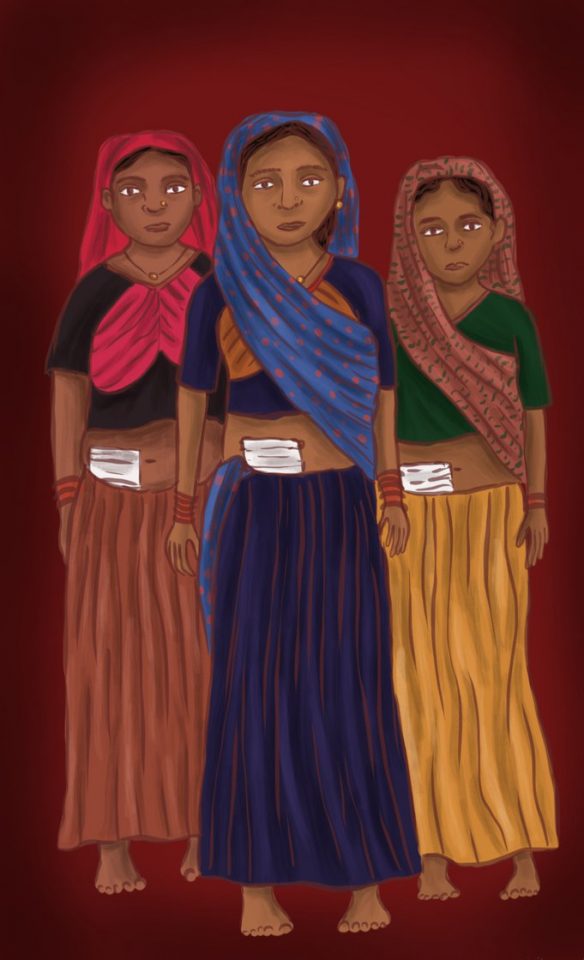
For Bhawrad women of Dholka, a tubectomy means opposing patriarchal social norms and overcoming their own fears
Jayaben confirms that men “go out and do wage labour. My man goes and lifts cement bags and gets some 200-250 rupees.” And he seems to be lucky that there is a cement factory nearby where he finds work most days. Her family, like many others here, does not have even a BPL (below poverty line) ration card.
Jayaben is fearful of using either oral contraceptives or a Copper-T to plan her pregnancies – even after two boys and a girl. Nor does she want to get the permanent operation done. “All my deliveries were at home. I am too scared of all those tools they use. I have seen a Thakor’s wife suffer after the operation.
“So I decided to ask our Meladi Ma. I cannot go for an operation without her permission. Why would Mataji permit me to chop a growing plant? But things are so expensive these days. How to feed so many mouths? So I told Mataji that I had enough children but was scared of an operation. I promised her an offering. Mataji has taken care of me for 10 long years. I have not had to take a single medicine.”
*****
The idea that her husband could undergo a vasectomy was surprising to Jayaben as well as to all the other women in the assembled group.
Their reaction reflects a national reluctance about male sterilisation. Across India, in 2017-18, of a “total 14,73,418 sterilization procedures, only 6.8% were male sterilization operations and an overwhelming 93.1% were female, states a report of the National Health Mission.
The prevalence and acceptance of vasectomies as a proportion of all sterilisations was higher 50 years ago than it is today, falling sharply in the late 1970s, particularly after the notorious forced sterilisations of the 1975-77 Emergency. That proportion sank from 74.2 per cent in 1970 to just 4.2 per cent in 1992, says a paper in the Bulletin of the World Health Organization .
Family planning continues to be seen largely as the responsibility of women.
Jeeluben, the only one in this group who underwent a tubectomy, recalls that before that procedure, “there was no question of asking my husband to use anything. I did not even know he could get an operation done. Anyway, we never talked about such things.” However, there were occasions, she says, when her husband on his own sometimes bought her emergency contraceptive pills from Dholka, at “Rs. 500 for three tablets.” That was in the years just before her tubectomy.
The National Family Health Survey’s Fact Sheet for the state (2015-16) notes that male sterilisations accounted for just 0.2 per cent of all family planning methods in rural Gujarat. Women bore the brunt of all other methods including female sterilisation, intrauterine devices and pills.
For the Bhawrad women of Dholka though, a tubectomy would mean going against patriarchal family and community norms, as well as overcoming their own fears.

The Community Health Centre, Dholka: poor infrastructure and a shortage of skilled staff add to the problem
“ASHA [accredited social health activist] workers take us to the government hospital,” says Kanakben Bharwad, Kantaben’s daughter-in-law, who is in her mid-20s. “But we are all scared.” She has heard of “an operation during which a lady died on the spot. The doctor cut the wrong tube by mistake and she died right there on the operation table. It is not even a year since that happened.”
But pregnancies too are risky in Dholka. A consulting doctor at the government-run Samuhik Aarogya Kendra (Community Health Centre, CHC) says illiteracy and poverty contribute to multiple pregnancies without a reasonable gap in between. And “no one comes regularly for a check-up” he says. Most of the women who visit the centre suffer from nutritional deficiencies and anaemia. “Around 90% of those coming here,” he estimates, “are found to have haemoglobin below 8 per cent.”
Compounding this is the poor infrastructure and a shortage of skilled staff in the community health centres. There are no sonography machines, and for long stetches no fulltime gynaecologist or affiliated anaesthetist available on call. One anaesthetist works across all six PHCs (primary health centres), one CHC, and several private hospitals or clinics in Dholka and patients have to pay separately for him.
Back in that room in Khanpar village, one angry voice breaks into the conversation on the lack of control women have over their own bodies. Carrying a one-year-old in her arms, a young mother asks with some asperity: “What do you mean who will decide? I will decide. It is my body; why should someone else decide? I know I don’t want another child. And I don’t want to take pills. So what if I conceive, the government has got medicines for us, have they not? I will take the medicine [injectable contraceptives]. Only I will decide.”
That’s a rare voice though. Still, as Ramila Bharwad had said at the beginning of the conversation: “Now things may be a little different.” Well, maybe, just a little.
The names of all the women in this story have been changed to maintain their privacy.
A special thanks to Janki Vasant of Samvedana Trust for her support.
PARI and CounterMedia Trust’s nationwide reporting project on adolescent girls and young women in rural India is part of a Population Foundation of India-supported initiative to explore the situation of these vital yet marginalised groups, through the voices and lived experience of ordinary people.
Want to republish this article? Please write to zahra@ruralindiaonline.org with a cc to namita@ruralindiaonline.org

